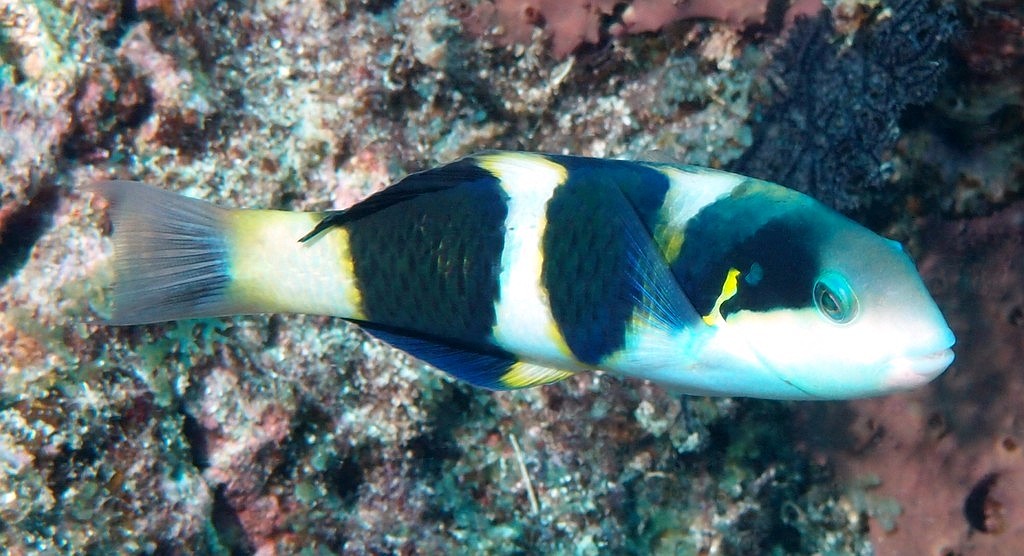THALASSOMA NIGROFASCIATUM - (RANDALL, 2003)
Actinopterygii (Gigaclass) > Actinopteri (Class) > Teleostei (Subclass) > Labriformes (Order) > Labroidei (Suborder) > Labridae (Family) > Thalassoma (Genus)
Girelle à quatre bandes noires, Blackbarred wrasse, Blackbar wrasse, Whitebar wrasse,
Description
Dorsal spines (total): 8; Dorsal soft rays (total): 13; Anal spines: 3; Anal soft rays: 11, the first spine, when detectable is very slender and short; Pectoral fin rays: 15-16 (usually: 15); Lateral line scales: 26-27; Vertebrae: 25; Head naked, except for a small patch of scales dorsally on opercle; Gill rakers: 20-23; Body depth: 5.9-3.6 in SL; Head length (HL): 3.1-3.4 in SL; Snout length: 8.4-9.8 in SL; Caudal peduncle depth: 6.2-6.65 in SL; Pectoral fins: 4.0-4.3 in SL; Pelvic fins: 6.3-6.9 in SL. The caudal fin is truncate in young individuals, becoming strongly lunate with filamentous lobes in adult males. Max. length: 20.0 cm SL. Depth range: 0 - 15 m.
Color
Girelle à quatre bandes noires, Blackbarred wrasse, Blackbar wrasse, Whitebar wrasse,
Description
Dorsal spines (total): 8; Dorsal soft rays (total): 13; Anal spines: 3; Anal soft rays: 11, the first spine, when detectable is very slender and short; Pectoral fin rays: 15-16 (usually: 15); Lateral line scales: 26-27; Vertebrae: 25; Head naked, except for a small patch of scales dorsally on opercle; Gill rakers: 20-23; Body depth: 5.9-3.6 in SL; Head length (HL): 3.1-3.4 in SL; Snout length: 8.4-9.8 in SL; Caudal peduncle depth: 6.2-6.65 in SL; Pectoral fins: 4.0-4.3 in SL; Pelvic fins: 6.3-6.9 in SL. The caudal fin is truncate in young individuals, becoming strongly lunate with filamentous lobes in adult males. Max. length: 20.0 cm SL. Depth range: 0 - 15 m.
Color
- The initial phase is white with postorbital head and anterior body above pectoral-fin base black with an oblique yellow band above dorsal edge of opercle, a black bar over last 4-5 dorsal spines continuing ventrally across body, its posterior edge vertical, and a broader black bar over last 9 soft rays of dorsal fin, across the body, and posterior anal fin; A black spot on first two membranes of dorsal fin.
- The terminal males with yellow partly replacing the white, a salmon pink patch on chin, and blue ventrally on head and chest.
Etymology
Thalassoma: from Greek, thalassa = the sea + from Greek, soma = body; The color of the sea.
nigrofasciatum: from Latin, nigro = black + from Latin, fascio = I envelop with bands, swathe. Named nigrofasciatum by reason of the four black bars on the body.
Original description: Thalassoma nigrofasciatum Randall, 2003 - Type locality: Phillips Point, Lord Howe Island, southwestern Pacific, depth 7.5 meters.
Distribution
Western Pacific: Papua New Guinea and eastern Australia, east to Fiji and Niue, south to Lord Howe Island (Australia), Kermadec Islands (New Zealand) and New Caledonia.
Biology
Found solitary or in groups, most commonly on outer reef areas, and also found in coastal reefs, lagoons and tide pools. Oviparous, distinct pairing during breeding.
Thalassoma: from Greek, thalassa = the sea + from Greek, soma = body; The color of the sea.
nigrofasciatum: from Latin, nigro = black + from Latin, fascio = I envelop with bands, swathe. Named nigrofasciatum by reason of the four black bars on the body.
Original description: Thalassoma nigrofasciatum Randall, 2003 - Type locality: Phillips Point, Lord Howe Island, southwestern Pacific, depth 7.5 meters.
Distribution
Western Pacific: Papua New Guinea and eastern Australia, east to Fiji and Niue, south to Lord Howe Island (Australia), Kermadec Islands (New Zealand) and New Caledonia.
Biology
Found solitary or in groups, most commonly on outer reef areas, and also found in coastal reefs, lagoons and tide pools. Oviparous, distinct pairing during breeding.
Hybrids can occur between Thalassoma lutescens (Lay & Bennett, 1839) or Thalassoma quinquevittatum (Lay & Bennett, 1839). These offspring do not appear to survive very long or perhaps they keep traveling in search of a mate. Rare hybrids between other endemic species and/or close cousins from the Pacific are known, like with Gomphosus varius (Lacepède, 1801).
An example (here) hybrid between Thalassoma lutescens (Lay & Bennett, 1839) and probably Thalassoma nigrofasciatum (Randall, 2003).
Similar species
An example (here) hybrid between Thalassoma lutescens (Lay & Bennett, 1839) and probably Thalassoma nigrofasciatum (Randall, 2003).
Similar species
Thalassoma jansenii (Bleeker, 1856) - Reported from Indo-West Pacific: Lakshadweep (India), Maldives and Sri Lanka, east to Micronesia, north to southern Japan, south to northwestern Australia. It is mostly black with narrower white or yellow bands.
Last update: 6, September 2024
Last update: 6, September 2024
